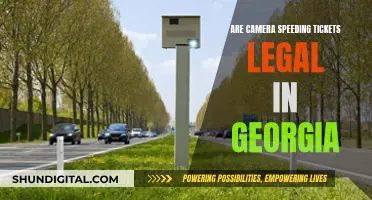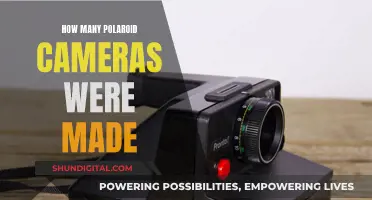
London has been dubbed the CCTV capital of the world, and for good reason. The city is home to hundreds of thousands of surveillance cameras, with estimates ranging from 500,000 to 691,000. With an average Londoner caught on camera 300 times a day, it's safe to say that London is one of the most heavily monitored cities in the world. But how did it come to this?
| Characteristics | Values |
|---|---|
| Number of CCTV cameras in London | 500,000-700,000 |
| Number of CCTV cameras on the London Underground | 15,516 |
| Number of CCTV cameras in King's Cross and St. Pancras | 408 |
| Number of CCTV cameras in Oxford Circus | 309 |
| Number of CCTV cameras in Elephant & Castle | 190 |
| Number of CCTV cameras in Bank/Monument | 182 |
| Number of CCTV cameras in Piccadilly Circus | 175 |
| Number of CCTV cameras in Wembley Park | 171 |
| Number of CCTV cameras in Canary Wharf | 167 |
| Number of CCTV cameras per person in London | 1 for every 11-15 people |
| Number of times the average Londoner is recorded on camera per day | 300 |
| Amount spent on the installation and operation of CCTV units in London between 2007 and 2010 | Over £300 million |
What You'll Learn

London's Underground CCTV network
London is often referred to as the CCTV capital of the world. The city is home to hundreds of thousands of CCTV cameras, and the average Londoner is recorded by a surveillance camera 300 times a day.
The London Underground network is one of the most highly monitored areas of the capital. There are 15,516 CCTV cameras in operation in the Underground alone, positioned at entrances and exits, in corridors, on platforms, and inside trains.
The stations with the most cameras are King's Cross St. Pancras Metropolitan Line (408), Oxford Circus Bakerloo Line (309), Waterloo Jubilee Line (303), Green Park Piccadilly Line (210), and Elephant & Castle Bakerloo Line (190). These stations are heavily monitored due to larger footfall and pedestrian traffic, crime hotspots, and nearby tourist areas.
The footage from the 15,516 cameras across the Underground network is held for two weeks. Transport for London (TfL) stresses that the images captured are for the safety of passengers and to aid in the prevention of crime.
TfL employees in customer-facing roles are also issued with body-worn CCTV cameras. These devices can capture audio recordings and are only switched on to record in the event of an incident or when a Revenue Protection Officer is taking enforcement action.
Camera Batteries: Airplane Safety and Legalities Explored
You may want to see also

Private vs. government-controlled cameras
London has a reputation for being one of the most heavily monitored cities in the world. The city is home to hundreds of thousands of CCTV cameras, with the average Londoner caught on camera 300 times a day.
The majority of London's CCTV cameras are not government-controlled but are owned and operated by private individuals and businesses. Cameras on business premises must be registered with the ICO (Information Commissioner's Office), but domestic CCTV cameras do not have to be registered if they only capture images within the owner's property. This means there are potentially hundreds of thousands of unregistered private CCTV cameras in London.
Cameras owned and operated by government bodies are a matter of public record, so we can be more certain of the number of government-controlled cameras. Transport for London uses a total of 15,516 cameras across the tube network, and the Metropolitan Police has a further 110. The City of London Council operates 651 cameras, and a BBC survey from 2009 found that there were 7,431 surveillance cameras in use across all the local councils in Greater London. This gives a total of 23,708 government-controlled cameras.
Given that private cameras are estimated to outnumber public cameras by as much as 70 to 1, we can assume that the vast majority of London's CCTV cameras are privately owned and operated.
The use of CCTV cameras in London, and the UK more broadly, has raised concerns about privacy and civil liberties. While CCTV can be a useful tool for crime prevention and law enforcement, it is important to ensure that the use of surveillance cameras does not infringe on the public's right to privacy. The UK government has introduced legislation to regulate the use of CCTV, such as the Surveillance Camera Code of Practice, which sets out a code of conduct for local governments and police forces operating video surveillance cameras.
LaView Cameras: Where Are They Manufactured?
You may want to see also

The cost of CCTV cameras
Initial Purchase Cost:
The price of a CCTV camera can range from a few hundred to a few thousand dollars, depending on factors such as image resolution, night vision capabilities, and smart features. For example, basic CCTV cameras with lower resolutions can be found for under $1000, while more advanced cameras with higher resolutions, night vision, and smart capabilities can cost upwards of $1000.
Installation Cost:
In addition to the cost of the camera itself, there may be additional costs for installation. Some CCTV cameras can be installed easily by the user, while others may require professional installation, which can add to the overall cost. The complexity of the installation will depend on factors such as the number of cameras, the location of the cameras, and the type of mounting required.
Maintenance and Repair Costs:
CCTV cameras require regular maintenance to ensure optimal performance. This may include cleaning the lenses, adjusting the focus, and updating software or firmware. In the event of a malfunction, there may be repair costs involved, which can vary depending on the issue and the availability of replacement parts.
Storage Costs:
CCTV cameras generate large amounts of video data, which requires sufficient storage capacity. This can be in the form of local storage devices such as hard drives or cloud-based storage solutions. The cost of storage will depend on the amount of footage being stored, the duration for which it needs to be stored, and the chosen storage solution.
Monitoring Costs:
For those who wish to have their CCTV system actively monitored, there may be additional costs for monitoring services. This can include hiring security personnel to monitor the footage in real-time or subscribing to a remote monitoring service that alerts authorities in the event of suspicious activity.
Additional Equipment Costs:
CCTV cameras may require additional equipment to function effectively, such as cables, connectors, power supplies, and monitors. These additional components can add to the overall cost of the CCTV system.
It is important to note that the cost of CCTV cameras can vary depending on the specific requirements and the chosen brand. It is always a good idea to research different options and compare prices before making a purchase decision.
Materials Used to Make Camera Bags
You may want to see also

Effectiveness of CCTV cameras
The effectiveness of CCTV cameras is a highly debated topic. While some claim that CCTV cameras are an invasion of privacy, others argue that they are necessary for crime prevention and public safety. So, what is the truth?
The Benefits of CCTV Cameras
One of the main reasons for the widespread use of CCTV cameras is their potential to deter crime and improve security. CCTV cameras can monitor public areas and personal property, and their presence may discourage criminal activity. The evidence suggests that CCTV cameras have led to a reduction in crime in certain areas, particularly car parks and, to a lesser extent, residential areas. The presence of CCTV cameras can increase offenders' perception of the risk of getting caught and encourage the public to use an area, thereby affecting criminals' perceptions of risk through increased informal surveillance. Additionally, CCTV cameras can aid in the detection of offenders and crowd control or public order scenarios.
The Drawbacks of CCTV Cameras
However, there is also evidence that CCTV cameras can have negative effects. One concern is the potential invasion of privacy and violation of civil liberties. The cost of installing and maintaining CCTV cameras can also be significant, especially for local governments and businesses. Another issue is the displacement of crime, where CCTV cameras may simply shift criminal activity to other areas rather than reducing it overall. There is also the possibility that an over-reliance on CCTV cameras could reduce the vigilance of police and the public, potentially leading to an increase in crime.
The Effectiveness of CCTV Cameras in London
London, often called the CCTV capital of the world, presents a unique case study for the effectiveness of CCTV cameras. With an estimated 500,000 to 691,000 CCTV cameras in the city, London has one of the highest densities of CCTV cameras in the world. The average person in London is caught on CCTV 300 times a day, and the city has the fourth-highest CCTV camera density worldwide. The majority of these cameras are owned by private individuals and businesses, with only about 3.4% being government-controlled.
The high number of CCTV cameras in London has been linked to a reduction in crime. For example, in 2009, 95% of Scotland Yard murder cases involved CCTV footage, providing invaluable evidence for the police and courts. However, it is challenging to determine the exact impact of CCTV cameras on crime rates, as there are many other factors at play.
In conclusion, while CCTV cameras have been shown to have some benefits in terms of crime reduction and public safety, there are also valid concerns about their effectiveness and potential drawbacks. The decision to implement CCTV cameras should be carefully considered, weighing the potential benefits against the risks to privacy and civil liberties.
A Year of Camera Tickets: How Many is Too Many?
You may want to see also

Concerns about privacy
London has long been known as the CCTV capital of the world. With an estimated 500,000 to 691,000 surveillance cameras, Londoners are caught on camera 300 times a day on average. This amounts to one camera for every 11 to 14 people.
While the use of CCTV can be beneficial in fighting crime and improving security, there are valid concerns about the impact of this extensive surveillance network on privacy. The UK has more surveillance cameras per person than any country in the world except China, and the combination of CCTV with facial recognition technology has raised particular worries about the erosion of civil liberties.
Privacy Concerns
The widespread use of CCTV in London has sparked concerns about the right to privacy and the potential for mass surveillance. While the UK government maintains that its surveillance practices are legal and necessary for national security, some civil liberties groups argue that current legislation does not provide sufficient protection for citizens' privacy.
One of the main concerns is the potential for misuse or abuse of CCTV footage. While the government assures that surveillance is used primarily for crime prevention and detection, there is a risk that footage could be accessed or shared without individuals' knowledge or consent. Additionally, the retention and storage of CCTV data raise questions about data protection and the potential for data breaches.
The use of facial recognition technology by the London Metropolitan Police has further intensified privacy concerns. Despite evidence of a high failure rate and concerns raised by privacy activists, the police have moved forward with implementing this technology. Facial recognition technology has been likened to turning "surveillance cameras into identity checkpoints," and many worry about the potential for arbitrary state interference and invasion of privacy.
Another issue is the lack of transparency and oversight regarding the use of CCTV. While there are laws and codes of practice in place, such as the Surveillance Camera Code of Practice, critics argue that these may not be sufficient to prevent potential abuses. The majority of CCTV cameras in London are owned and operated by private individuals and businesses, and the exact number of cameras is difficult to ascertain due to varying registration requirements.
Furthermore, there are concerns about the potential for discrimination and profiling with the use of facial recognition technology. Research has shown that this technology often exhibits higher error rates when identifying people of colour, and there are worries that it could be used to target or profile specific ethnic or demographic groups.
The extensive use of CCTV in London has also sparked a broader debate about the balance between security and privacy. While some may feel safer with the presence of surveillance cameras, others may feel that their right to anonymity and freedom of movement is being infringed upon. The normalisation of CCTV and the potential for future expansion into more advanced forms of monitoring, such as biometric surveillance, raise important questions about the boundaries of surveillance in a democratic society.
In conclusion, while the use of CCTV in London may have benefits in terms of crime prevention and public safety, it is essential to carefully consider the potential implications for privacy and civil liberties. Finding the appropriate balance between security and privacy is a complex and ongoing challenge, and one that requires continued scrutiny and public discussion.
Mastering Focus Techniques with Medium Format 6x9 Cameras
You may want to see also
Frequently asked questions
Estimates vary, with some sources claiming there are 500,000 CCTV cameras in London, while others state the number to be over 942,562.
The high number of CCTV cameras in London is due to a combination of criminal activity and legal requirements. Businesses and homeowners install CCTV cameras to enhance security and deter crime.
BBC statistics show that the boroughs of Wandsworth and Camden have the highest number of cameras per 1,000 people. King's Cross and St. Pancras stations have the most cameras out of all stations in London, with 408 cameras monitoring approximately 81 million people per year.
An average person in London is estimated to be recorded on CCTV between 70 and 300 times a day.







